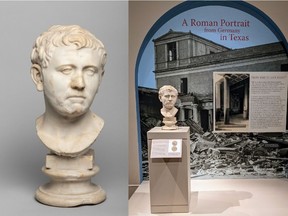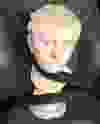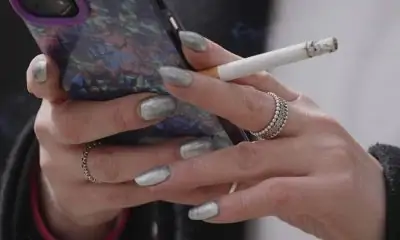Article content
When Lynley McAlpine was growing up in the small Saskatchewan town of Aylesbury, she never imagined her love of history would make her an international media star.
‘I can honestly say that nothing I’ve learned about SAMA’s collection so far is as wild as this royal German art collection to WWII looting to Goodwill story!’

When Lynley McAlpine was growing up in the small Saskatchewan town of Aylesbury, she never imagined her love of history would make her an international media star.
McAlpine, who is a Roman art expert, has been working since 2018 on finding out more about an ancient bust, or portrait, bought for $34.99 at a Goodwill store in Austin, Texas.
The rare find is now finally on display in an exhibit curated by McAlpine at the San Antonio Museum of Art (SAMA) in San Antonio, Texas, where she is the Andrew W. Mellon Postdoctoral Curatorial Fellow. And McAlpine’s phone has been running hot ever since.
“I knew that people would be fascinated by the story when it came out, but I hadn’t anticipated just how much it would blow up! In the last few days I have spent hours on the phone being interviewed by the BBC, the New York Times, the Washington Post, CNN, and more than a dozen other local, national, and international news organizations. That’s very different from my normal work, which mostly involves sitting at my desk reading and writing,” McAlpine said in an email interview with the Saskatoon StarPhoenix.

McAlpine was first invited to view the thrift store bargain in 2018 along with other Roman art experts by Laura Young, the art collector who discovered it.
The bust — produced in Rome sometime between late 1st century BC to the early 1st century AD — was once housed in a German museum decades ago, after being acquired by the Bavarian king Ludwig I, who displayed it in a full-scale replica of a home in Pompeii (called the Pompejanum) in Aschaffenburg, Germany.
The Pompejanum stood for more than a century before it was heavily bombed by Allied fighters during Second World War. It is not known how the bust ended up in Texas. The Bavarian government confirmed the authenticity of the find, but told Young she couldn’t sell it.
“In January 2019, Laura Young asked me and a colleague from SAMA if we would like to come and see it again to consider displaying it at SAMA once her agreement with the German government had been completed. We did want to display it, but it was a long process, made even longer by COVID, and it only finally arrived at SAMA last month,” McAlpine said.
McAlpine has a Ph.D. in Roman art and archeology from the University of Michigan and worked on researching the portrait’s history, both in ancient Rome and in 19th and 20th centuries Germany. She is also the curator for the exhibition displaying the bust at SAMA.
“It has definitely been a lot of fun to work on. My main work at SAMA is provenance research, which is all about trying to uncover the modern histories of artworks in the museum and making sure nothing was stolen or looted in the past,” she said.

“It’s fascinating work and I’ve found lots of interesting things, but I can honestly say that nothing I’ve learned about SAMA’s collection so far is as wild as this royal German art collection to WWII looting to Goodwill story!”
McAlpine attended Craik School in Saskatchewan, where history “was always my favourite subject”, and then majored in Classical Studies (ancient Greece and Rome) at Western University in London, Ontario.
“I had a lot of wonderful teachers and mentors in Canada. I usually try to go back to Saskatchewan a couple of times a year, but because of COVID I haven’t been there since 2019. I have plans to get home this coming August, though. Fingers crossed,” McAlpine said.
“I definitely don’t miss the winters, but to be honest, south Texas summers are just as miserable for me. It’s 39 degrees Celsius here today, and it’s only the beginning of May! I’m looking forward to going north for part of the summer,” she said on Saturday.
The discovery was just as exciting for Young, who is often on the hunt for rare art pieces and who took the 52 lb marble bust outside for a closer look under some natural light, she told the New York Times.
“He had chips to the base. He had clear repairs. He looks old. I’ve been to museums. I’ve seen Roman portrait heads before,” Young said.
Young strapped the bust, which still had a yellow price tag on its cheek, into the front seat of her car and took it home, where she decided to follow her hunch and contacted the experts.
The bust will be displayed at the San Antonio Museum of Art until May 2023, after which it will be returned to Germany.

with files from the National Post and the New York Times


The news seems to be flying at us faster all the time. From COVID-19 updates to politics and crime and everything in between, it can be hard to keep up. With that in mind, the Saskatoon StarPhoenix has created an Afternoon Headlines newsletter that can be delivered daily to your inbox to help make sure you are up to date with the most vital news of the day. Click here to subscribe.

LONDON (AP) — With a few daubs of a paintbrush, the Brontë sisters have got their dots back.
More than eight decades after it was installed, a memorial to the three 19th-century sibling novelists in London’s Westminster Abbey was amended Thursday to restore the diaereses – the two dots over the e in their surname.
The dots — which indicate that the name is pronounced “brontay” rather than “bront” — were omitted when the stone tablet commemorating Charlotte, Emily and Anne was erected in the abbey’s Poets’ Corner in October 1939, just after the outbreak of World War II.
They were restored after Brontë historian Sharon Wright, editor of the Brontë Society Gazette, raised the issue with Dean of Westminster David Hoyle. The abbey asked its stonemason to tap in the dots and its conservator to paint them.
“There’s no paper record for anyone complaining about this or mentioning this, so I just wanted to put it right, really,” Wright said. “These three Yorkshire women deserve their place here, but they also deserve to have their name spelled correctly.”
It’s believed the writers’ Irish father Patrick changed the spelling of his surname from Brunty or Prunty when he went to university in England.
Raised on the wild Yorkshire moors, all three sisters died before they were 40, leaving enduring novels including Charlotte’s “Jane Eyre,” Emily’s “Wuthering Heights” and Anne’s “The Tenant of Wildfell Hall.”
Rebecca Yorke, director of the Brontë Society, welcomed the restoration.
“As the Brontës and their work are loved and respected all over the world, it’s entirely appropriate that their name is spelled correctly on their memorial,” she said.
The Canadian Press. All rights reserved.

In a case that has sent shockwaves through the Vancouver Island art community, a local art dealer has been charged with one count of fraud over $5,000. Calvin Lucyshyn, the former operator of the now-closed Winchester Galleries in Oak Bay, faces the charge after police seized hundreds of artworks, valued in the tens of millions of dollars, from various storage sites in the Greater Victoria area.
Alleged Fraud Scheme
Police allege that Lucyshyn had been taking valuable art from members of the public under the guise of appraising or consigning the pieces for sale, only to cut off all communication with the owners. This investigation began in April 2022, when police received a complaint from an individual who had provided four paintings to Lucyshyn, including three works by renowned British Columbia artist Emily Carr, and had not received any updates on their sale.
Further investigation by the Saanich Police Department revealed that this was not an isolated incident. Detectives found other alleged victims who had similar experiences with Winchester Galleries, leading police to execute search warrants at three separate storage locations across Greater Victoria.
Massive Seizure of Artworks
In what has become one of the largest art fraud investigations in recent Canadian history, authorities seized approximately 1,100 pieces of art, including more than 600 pieces from a storage site in Saanich, over 300 in Langford, and more than 100 in Oak Bay. Some of the more valuable pieces, according to police, were estimated to be worth $85,000 each.
Lucyshyn was arrested on April 21, 2022, but was later released from custody. In May 2024, a fraud charge was formally laid against him.
Artwork Returned, but Some Remain Unclaimed
In a statement released on Monday, the Saanich Police Department confirmed that 1,050 of the seized artworks have been returned to their rightful owners. However, several pieces remain unclaimed, and police continue their efforts to track down the owners of these works.
Court Proceedings Ongoing
The criminal charge against Lucyshyn has not yet been tested in court, and he has publicly stated his intention to defend himself against any pending allegations. His next court appearance is scheduled for September 10, 2024.
Impact on the Local Art Community
The news of Lucyshyn’s alleged fraud has deeply affected Vancouver Island’s art community, particularly collectors, galleries, and artists who may have been impacted by the gallery’s operations. With high-value pieces from artists like Emily Carr involved, the case underscores the vulnerabilities that can exist in art transactions.
For many art collectors, the investigation has raised concerns about the potential for fraud in the art world, particularly when it comes to dealing with private galleries and dealers. The seizure of such a vast collection of artworks has also led to questions about the management and oversight of valuable art pieces, as well as the importance of transparency and trust in the industry.
As the case continues to unfold in court, it will likely serve as a cautionary tale for collectors and galleries alike, highlighting the need for due diligence in the sale and appraisal of high-value artworks.
While much of the seized artwork has been returned, the full scale of the alleged fraud is still being unraveled. Lucyshyn’s upcoming court appearances will be closely watched, not only by the legal community but also by the wider art world, as it navigates the fallout from one of Canada’s most significant art fraud cases in recent memory.
Art collectors and individuals who believe they may have been affected by this case are encouraged to contact the Saanich Police Department to inquire about any unclaimed pieces. Additionally, the case serves as a reminder for anyone involved in high-value art transactions to work with reputable dealers and to keep thorough documentation of all transactions.
As with any investment, whether in art or other ventures, it is crucial to be cautious and informed. Art fraud can devastate personal collections and finances, but by taking steps to verify authenticity, provenance, and the reputation of dealers, collectors can help safeguard their valuable pieces.
[unable to retrieve full-text content]
Ukrainian sells art in Essex while stuck in a warzone BBC.com

Source link


Canadanewsmedia news October 18, 2024: Testy B.C. election campaign reaches final day


US to probe Tesla’s ‘Full Self-Driving’ system after pedestrian killed in low visibility conditions


Advocates urge Ontario to change funding for breast prostheses, ostomy supplies


More details expected on proposed deal that would see tobacco giants pay billions


‘Kindness’ influencers on TikTok give money to strangers. Why is that controversial?


Housing, health, and plastic straws: Here’s how B.C. politicians are wooing voters


Testy B.C. election campaign sees leaders attacking each other more than policy


Rwanda shrugs off ‘sportswashing’ criticism in pursuit of a winning development formula